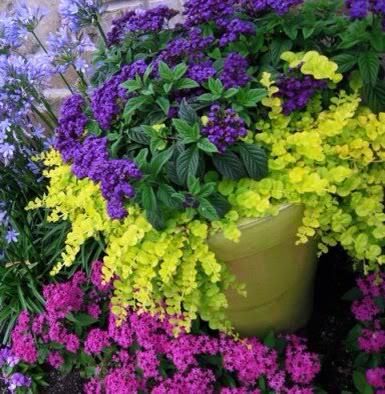Choosing Plants for a Perennial Container

Many people are very comfortable planting up containers with annual planting, such as summer bedding, but how about planting up a container with perennials? The considerations for what to put in are rather different, because your plants may well grow more slowly, but eventually reach much larger sizes. But the rewards are a display that grows and changes year by year, and much more variety of planting than is possible with an annual display. Here are our top tips for choosing plants for a perennial container display. Don't forget you can visit our Grow Your Own section for all the tools and equipment you need to get started.
- Choose your container
Given the variety of containers available, you really need to start with the container, as this will dictate how many plants, and what type, you will be able to grow. Remember that unglazed terracotta pots lose moisture much quicker than glazed ones, and that plastic pots are lighter and so may be easier to move once the display is no longer so good, in winter.
2. Decide on your planned location
Your location will also dictate which plants you will be able to grow, for example, those that will tolerate shade, or those that like full sun. So decide where your container will be and look carefully at the conditions to decide what plants will suit the location.
3. Select plants that like similar conditions
You may love both thymes and hostas, but it’s no good. They don’t like the same conditions, and won’t enjoy being in a pot together. You need to choose plants that will tolerate the same soil conditions. If in doubt, use the plant labels in the garden centre or nursery as a guide. As a rough guide, yellow-leaved plants will be better in shade, grey-leaved plants will enjoy full sun.
4. Choose complementary plant colours and sizes
You want your container to look good, so pick plants whose flower and leaf colours will complement each other and your chosen container. It’s also as well to choose plants that will grow at similar speeds, so that one doesn’t take over the pot.
5. Choose the right growing medium
You can buy compost, topsoil and such a wide variety of growing media from compost suppliers that there really is no excuse for getting it wrong. As a general guide, mushroom compost, or spent mushroom compost and manure compost, will provide good growing conditions for most containers, although you may want to mix them with some topsoil to improve water retention. Horse manure works well too but that is more suited to industrial size operations rather than small pot growings. Add some slow release fertiliser pellets to help your plants to grow nicely, and then you’re ready to plant up your containers.
And finally, don't forget to water your plants regularly in summer or in dry periods, as pots of perrenials dry out quite quickly, just like annual containers.